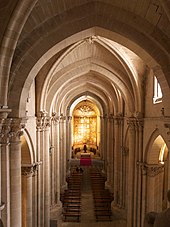Salamanca old cathedral
The old Cathedral of Salamanca ( Catedral Vieja de Santa María del Asedio ) in central Spain, together with the adjoining larger new cathedral, is the episcopal church of the Roman Catholic diocese of Salamanca . The Romanesque - early Gothic basilica received the rank of basilica minor in 1854 . Since 1988 it has been part of the UNESCO World Heritage Site of Salamanca's old town .
history
The diocese of Salamanca derives its tradition from early Christian times. However , there is no reliable evidence of the Roman , Visigoth and Moorish periods. It is uncertain whether today's cathedral had a Mozarabic predecessor.
In the course of the Reconquista , the diocese was restored in 1102. Construction of today's old cathedral began around 1150, and that of the cloister in 1162 . The work dragged on well into the 13th century. The cathedral school was founded in 1174 , from which the University of Salamanca emerged in 1218 . Construction of the new cathedral, more than twice as large, to the north of the old one, began in 1513 and lasted until 1733.
architecture
The church is a cruciform basilica. The nave is 52 m long and the central nave is 16.70 m high. All three naves close with semicircular apses . The left arm of the transept was cut off when the new cathedral was built. The most striking part of the building is the octagonal crossing tower ( Torre del Gallo ) with four decorative gables and four decorative towers. It is richly decorated inside and outside with late Romanesque figures and capitals . The vaults of the nave show the transition to Gothic. The main portal, only parts of which are rich in figures, is flanked by an annunciation group .
The west building of the cathedral has two towers and was originally designed as a fortification. The south tower was only built up to the height of the central nave. The mighty north tower with the bells, which belongs to both the old and the new cathedral, did not get its current baroque - classicist shape until the 18th century after a fire and the Lisbon earthquake in 1755 .

The cloister, originally influenced by the Moorish , was also restored in classical form after being destroyed in the Lisbon earthquake and increased by one storey.
Furnishing
Inside, the Gothic wall painting has largely been preserved. It is one of the most outstanding of its kind in Europe. The altars and pictures of the numerous chapels from different epochs are also of the highest quality.
Individual evidence
- ↑ gcatholic.org ; “Holy Mary of the Siege” in memory of a siege of Salamanca by Almansor in 977
- ↑ Catedral Vieja ( Memento of the original from May 26, 2012 in the Internet Archive ) Info: The archive link has been inserted automatically and has not yet been checked. Please check the original and archive link according to the instructions and then remove this notice.
- ↑ Cronograma de Historia de la Catedral ( Memento of the original dated February 29, 2012 in the Internet Archive ) Info: The archive link was inserted automatically and has not yet been checked. Please check the original and archive link according to the instructions and then remove this notice.
- ↑ Floor plan of both cathedrals and the cloister ( memento of the original dated February 9, 2014 in the Internet Archive ) Info: The archive link was inserted automatically and has not yet been checked. Please check the original and archive link according to the instructions and then remove this notice. with detailed legend
Web links
- Description (website of the cathedral, Spanish)
Coordinates: 40 ° 57 ′ 37.6 " N , 5 ° 39 ′ 59.3" W.

